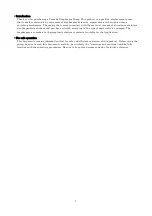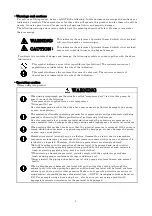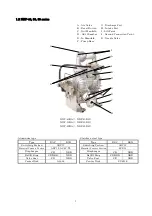
2
- Warnings and cautions
For safe use of this product, be sure to NOTE the following: In this document, warnings and cautions are
indicated by symbols. These symbols are for those who will operate this product and for those who will be
nearby, for safe operation and for prevention of personal injury and property damage.
The following warning and caution symbols have the meanings described below. Be sure to remember
their meanings.
WARNING :
This indicates the existence of potential hazard which, if not avoided,
will result in death or serious injury.
CAUTION :
This indicates the existence of potential hazard which, if not avoided,
may result in bodily injury or in physical damage.
To indicate the contents of danger and damage, the following symbols are used together with the above
indications.
This symbol indicates an act that is prohibited (prohibition). The concrete contents of
prohibition are indicated by the side of the indication.
This symbol indicates the contents that must be observed. The concrete contents of
observance are indicated by the side of the indication.
- Operating caution
Before using this product
WARNING
- When using compressed gas (hereinafter called "compressed air") to drive this pump, be
sure it is one of the following:
* Compressed air supplied from an air compressor
* Nitrogen (N
2
) gas
Use of compressed air other than the above may cause air pollution, damage to the pump,
or even an explosion.
- The maximum allowable operating pressure for compressed air and powder material being
pumped is shown in [9.1 Main specifications] as Operating Air Pressure.
Use of compressed air or powder material which exceeds the operating air pressure can
cause material leaks, damage to the pump casings and diaphragms, or even fatal accidents.
- When moving this product, make sure that the internal pressure is released. If the pump is
moved while under pressure, any shock imparted by droppage, etc. may damage the pump
or even cause an explosion.
- Hazardous material (strongly-acid or -alkaline, flammable, or toxic) and its atmosphere
may cause serious injury or even death if it comes in contact with your eyes or skin or if it
is inhaled or ingested. Therefore, the following precautions are strongly advised.
*Be fully familiar with the properties of the material to be pumped and work in strict
accordance with the operating instructions provided by the suppliers of such materials
(such as wearing goggles, gloves, mask or work clothes).
*When storing a hazardous material, strictly comply with the regulatory procedures
(such as using proper containers, storage conditions, etc.).
*Always install the piping and exhaust port of this pump away from human and animal
traffic.
- When a diaphragm is damaged, material will gush out together with air through the
exhaust port. Also when pump has positive suction head, material will be forced out from
exhaust port due to positive inlet pressure. Make sure to provide protective measures in
consideration of possible leakage of material (see
<
NOTE
>
Arranging outside exhaust on
P.9). For example using a hose and pit etc., also be sure you are using a model with
appropriate corrosion resistance for the material to be pumped.




































